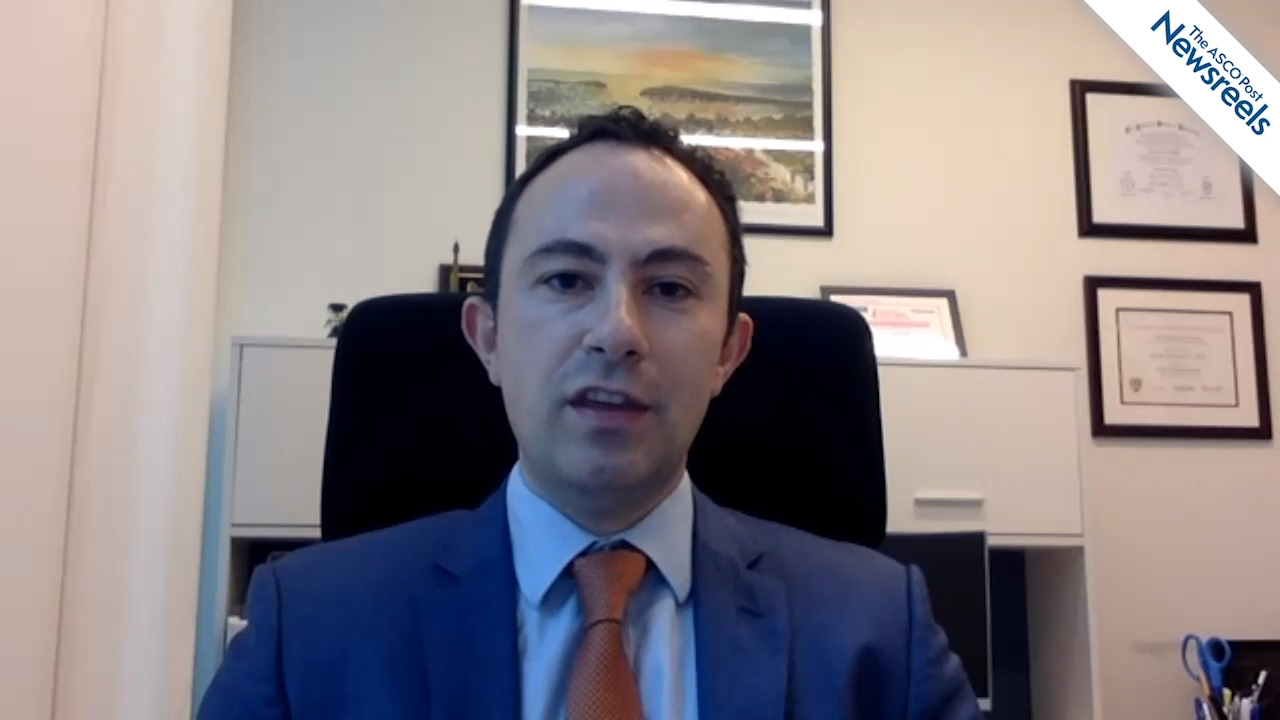Beyond BROCADE3: Just the Beginning for Veliparib-Based Therapy in Advanced BRCA-Mutated Breast Cancer
As recently reported in The Lancet Oncology and reviewed in the October 10, 2020, issue of The ASCO Post, the phase III BROCADE3 trial has shown that the addition of veliparib to carboplatin and paclitaxel improved progression-free survival in previously treated BRCA-mutated advanced breast...
Predicting Cardiovascular Disease Risk Via Routine CT Scans in Women With Breast Cancer
Coronary artery calcification scores based on routine computed tomography (CT) scans used for planning radiotherapy therapy may be able to predict which women with breast cancer have a high probability of developing cardiovascular disease. The promise of this research is that once high-risk...
Expert Point of View: Charles L. Shapiro, MD
The ASCO Post asked Charles L. Shapiro, MD, Professor of Medicine, Director of Translational Breast Cancer Research, and Director of Cancer Survivorship at Icahn School of Medicine at Mount Sinai, New York, for his thoughts on the exploratory analysis of PALOMA-3. He first pointed out that the...
PALOMA-3 Exploratory Analysis: Who Benefits Most From Palbociclib?
The phase III PALOMA-3 trial significantly reduced the risk of disease progression by 50% in patients with hormone receptor–positive/HER2-negative advanced breast cancer, but the improvement in overall survival did not reach statistical significance.1 An exploratory subgroup analysis has now shown...
Surgery Improves Survival in Older Women With Early Estrogen Receptor–Positive Breast Cancer
Older women with estrogen receptor–positive breast cancer have poorer survival than younger women, but this gap might be closed by offering surgery to women over age 70 who are fit and have resectable tumors. According to a study presented at the 12th European Breast Cancer Conference (EBCC 12),...
First-Line Pembrolizumab Delays Disease Progression in PD-L1–Expressing Metastatic Triple-Negative Breast Cancer
In the phase III KEYNOTE-355 trial, pembrolizumab combined with several chemotherapy partners yielded a statistically significant and clinically meaningful improvement in progression-free survival vs chemotherapy alone in patients with previously untreated locally advanced or metastatic...
Recently Approved and Emerging Therapies for Triple-Negative Breast Cancer
“Triple-negative breast cancer has multiple different subtypes, and there are targeted therapies that can be used based on the biomarkers that we identify for each patient,” Kari B. Wisinski, MD, noted in a review of recently approved and emerging therapies at the 2020 Lynn Sage Breast Cancer...
FDA Approves Companion Diagnostic for Three Targeted Therapies for Advanced Ovarian, Breast, and Non–Small Cell Lung Cancers
On October 27, 2020, the U.S. Food and Drug Administration (FDA) approved the FoundationOne Liquid CDx test for three new companion diagnostic indications to help match patients who may benefit from treatment with specific FDA-approved targeted therapies. The new indications are for alpelisib...
Olaparib for Patients With Metastatic Breast Cancer and Mutations in Homologous Recombination–Related Genes
In a phase II Translational Breast Cancer Research Consortium (TBCRC) study (TBCRC 048; Olaparib Expanded) reported in the Journal of Clinical Oncology, Nadine M. Tung, MD, and colleagues found that olaparib produced high response rates in patients with metastatic breast cancer and germline PALB2...
Potential Factors in Prognostic Discrepancies Among Tests for Recurrence Risk in Patients With Breast Cancer Receiving Endocrine Therapy
The TransATAC study reported by Buus et al in the Journal of Clinical Oncology sought to identify causes of discrepancies among tests for determining the risk of breast cancer recurrence in patients with estrogen receptor–positive, HER2-negative disease receiving endocrine therapy. The...
Immediate Breast Reconstruction vs Conventional Mastectomy After Neoadjuvant Chemotherapy: Long-Term Outcomes
In a Korean single-institution study reported in JAMA Surgery, Wu et al found no differences in long-term breast cancer outcomes between women who underwent immediate breast reconstruction with nipple-sparing or skin-sparing mastectomy vs those who underwent conventional mastectomy alone after...
Breast Cancer Risk and Disease-Causing Genetic Mutations in Women Older Than 65
Women with breast cancer onset after age 65 often do not qualify for genetic testing, yet little is known about the frequency of disease-causing mutations in breast cancer predisposition genes in this population. In a new study, researchers investigated the prevalence of disease-causing variants in ...
Effect of Early Trastuzumab Interruption on Recurrence-Free Survival in HER2-Positive Breast Cancer
In a single-center analysis reported in a research letter in JAMA Oncology, Copeland-Halperin et al found that early trastuzumab interruption and interruption resulting in a cumulative trastuzumab dose ≤ 56 mg/kg were associated with significantly poorer recurrence-free survival in patients with...
Alphonse G. Taghian, MD, PhD, on Irradiation for Breast Cancer: Defining the Optimal Dose
Alphonse G. Taghian, MD, PhD, of Massachusetts General Hospital, reviews the 10-year follow-up of a dose-escalation trial studying accelerated partial-breast irradiation and discusses the optimal dose, adverse effects, and cosmetic outcomes (Abstract 25).
Youssef Zeidan, MD, PhD, on HER2-Positive Breast Cancer: Deintensifying Radiation Therapy
Youssef Zeidan, MD, PhD, of the American University of Beirut Medical Center, discusses study findings showing that breast-conserving surgery, whole-breast irradiation, and trastuzumab offer effective local tumor control for patients with HER2-positive breast cancer. An additional radiation boost does not seem to further improve outcomes (Abstract 52).
Juliane Hörner-Rieber, MD, on Breast Cancer: Boosting Intensity-Modulated and Conventional Radiotherapies
Juliane Hörner-Rieber, MD, of Heidelberg University Hospital, discusses phase III results of the MINT trial, which showed that conventionally fractionated intensity-modulated radiotherapy with a simultaneous integrated boost was noninferior to three-dimensional conformal radiotherapy followed by a sequential boost for both local control and cosmesis in patients with breast cancer (Abstract 19).
FDA Approves Companion Diagnostic for Three Targeted Therapies for Advanced Ovarian, Breast, and Non–Small Cell Lung Cancers
On October 27, the U.S. Food and Drug Administration (FDA) approved the FoundationOne Liquid CDx test for three new companion diagnostic indications to help match patients who may benefit from treatment with specific FDA-approved targeted therapies. The new indications are for alpelisib (Piqray) in ...
Trends and Outcomes Among Hispanic Women of Different Races With Breast Cancer
In a National Cancer Database analysis reported in JCO Oncology Practice, Champion et al identified patterns in disease characteristics, time to surgery, and overall survival among Hispanic patients of different races and among Hispanic and non-Hispanic women of the same race. Study Details The...
Expect Questions About Increased Cancer Mortality Risk Among Patients Diagnosed With DCIS
A large cohort study1 finding that the risk of dying of breast cancer was increased threefold after a DCIS diagnosis may cause patients diagnosed with DCIS to ask what they can do to reduce that risk. Currently, there is little that most patients can do. “The lifetime risk of death following DCIS...
Focus on Preventing Invasive Recurrence in Women With DCIS Does Not Sufficiently Address Breast Cancer Mortality
A study published recently by Giannakeas et al looked at the risk of death from breast cancer for women diagnosed with ductal carcinoma in situ (DCIS).1 The investigators anticipated that treatment would eliminate the risk of invasive ipsilateral recurrence and prevent subsequent mortality from...
Sacituzumab Govitecan Yields Survival Benefit as Third-Line Treatment in Triple-Negative Breast Cancer: ASCENT Trial
Based on results from a phase I/II clinical trial, the antibody drug conjugate sacituzumab govitecan was recently granted accelerated approval in the treatment of patients with advanced triple-negative breast cancer, contingent on a larger study confirming its benefit. The confirmatory phase III...
Should Body Mass Index Guide the Choice of Chemotherapy in Patients With Breast Cancer?
The rate of obesity is rising dramatically in the United States and Europe, with more than 60% of women in the United States1,2 and 50% of women in Europe3 classified as overweight or obese based on their body mass index (BMI). Obesity is associated with an increased risk of hormone...
Effect of Virtual Tumor Board Implementation on Use of Whole-Breast Hypofractionated Radiation Therapy
In an observational cohort study reported in JCO Oncology Practice, Powell et al found that the use of whole-breast hypofractionated radiotherapy increased among patients with breast cancer with health insurance plans from one national health-care organization after the implementation of a virtual...
Are Delays in Breast Cancer Treatment as Harmful as Commonly Thought?
Delays in the treatment of breast cancer matter, but not as much “as we and our patients typically assume,” Richard J. Bleicher, MD, FACS, informed participants at the 22nd Annual Lynn Sage Breast Cancer Symposium.1 Some of these delays are unavoidable and others are tradeoffs that must be made to...
Final Efficacy Results From the ExteNET Trial: Neratinib in Pretreated Patients With HR-Positive, HER2-Positive Early Breast Cancer
In an analysis from the phase III ExteNET trial reported in Clinical Breast Cancer, Arlene Chan, MD, and colleagues found significant improvements in efficacy outcomes with the administration of neratinib vs placebo starting at 1 year or sooner after neoadjuvant/adjuvant trastuzumab-based therapy...
Limited English-Language Proficiency May Affect Frequency of Screening Mammograms
Limited English-language proficiency may be a risk factor for receiving screening mammograms less often, according to new study results using national data. These findings, concerning women age 40 and older living in the United States, were presented at the American College of Surgeons Clinical...
Addition of Atezolizumab to T-DM1 in Previously Treated Patients With HER2-Positive Advanced Breast Cancer
In the phase II KATE2 trial reported in The Lancet Oncology, Leisha A. Emens, MD, and colleagues found that the addition of atezolizumab to ado-trastuzumab emtansine (T-DM1) did not improve progression-free survival in patients with advanced HER2-positive breast cancer progressing after previous...
Melissa K. Accordino, MD, on Breast Cancer Care Delivery: Impact of the COVID-19 Pandemic
Melissa K. Accordino, MD, of Columbia University Medical Center, discusses findings showing nearly half of the patients with breast cancer treated at an academic center in New York City experienced a change or delay in their workup or treatment during the COVID-19 pandemic. Race and socioeconomic factors played a significant role (Abstract 88).
Clinical Challenges of Managing Breast Cancer Brain Metastases
“Breast cancer brain metastases are a clinical challenge that are only increasing in incidence and are a consequence of advanced breast cancers, largely HER2-positive and triple-negative,” according to Carey K. Anders, MD, Professor of Medicine and Medical Director of the Duke Brain and Spine...
Do Hospitals That Primarily Serve Minority Patients Offer Standard Surgical Care for Patients With Breast Cancer?
Among accredited cancer centers in the United States, hospitals serving primarily minority patients are as likely as other hospitals to offer the standard of surgical care for early-stage breast cancer, according to results presented at the virtual American College of Surgeons Clinical Congress...
Can Routine Scans Help Predict Which Patients With Breast Cancer May Be at Risk for Heart Disease?
Automated analysis of the routine scans of patients with breast cancer may help to predict which women have a greater risk of developing cardiovascular disease, according to research presented by Gal et al at the 12th European Breast Cancer Conference (Abstract 7). Women who have been treated for...
NeoALTTO Trial: Final Analysis Examines Neoadjuvant Lapatinib/Trastuzumab in HER2-Positive Breast Cancer
Final analysis of results from a randomized clinical trial of lapatinib and trastuzumab given before surgery in patients with early HER2-positive breast cancer has found that women who had a pathologic complete response survived longer without cancer recurrence than patients who did not. This was...
Addition of Veliparib to Carboplatin/Paclitaxel in BRCA-Mutated Advanced Breast Cancer
As reported in The Lancet Oncology by Véronique Diéras, MD, of the Institut Curie, Paris, and Centre Eugène Marquis, Rennes, and colleagues, the phase III BROCADE3 trial has shown a significant improvement in progression-free survival with the addition of the poly (ADP-ribose) polymerase (PARP)...
Trends to Watch in Early-Onset Cancer Among Young Adults
Although cancer incidence and mortality rates for all cancers combined are considerably lower in younger adults than older adults, a disturbing pattern is beginning to emerge in the development of early-onset cancers, typically diagnosed in older patients, occurring in younger adults. The rising...
Eliminating Routine Opioids While Maintaining Pain Control for Women Undergoing Lumpectomy or Excisional Biopsy
Changing from routinely prescribing opioids for patients who were having a lumpectomy or excisional biopsy to instead routinely prescribing nonsteroidal anti-inflammatory drugs [NSAIDs] resulted in a sharply decreased opioid prescription rate with “no difference in the proportion of patients...
Expert Point of View: George W. Sledge, Jr, MD
The results of monarchE were discussed by George W. Sledge, Jr, MD, Professor of Medicine and Chief of Oncology at Stanford University Medical Center, who offered some possibilities as to why its results were positive and those for palbociclib, in the phase III PALLAS trial, were “resoundingly...
Addition of Abemaciclib to Endocrine Therapy Reduces Recurrence in Early Breast Cancer
For the first time, an inhibitor of cyclin-dependent kinases 4 and 6 (CDK4/6) has reduced the risk of invasive disease recurrence in patients with early breast cancer when combined with standard endocrine therapy, investigators reported at the European Society for Medical Oncology (ESMO) Virtual...
Phase III NALA Trial Meets Primary Endpoint in Previously Treated HER2-Positive Breast Cancer
As reported in the Journal of Clinical Oncology by Cristina Saura, MD, of Vall d’Hebron University Hospital, Barcelona, and colleagues, the phase III NALA trial has shown significantly prolonged progression-free survival with the irreversible pan-HER tyrosine kinase inhibitor neratinib plus...
Tucatinib Combination Extends Survival in HER2-Positive Metastatic Breast Cancer, Including Patients With Brain Metastases
For patients with progressing HER2-positive metastatic breast cancer previously treated with trastuzumab, pertuzumab, and ado-trastuzumab emtansine (T-DM1), no single regimen is an established standard of care. More than 50% of these patients will develop brain metastasis, and thus far, treatments...
Managing Breast Cancer in a Pregnant Patient
“One of the most challenging oncologic situations is the diagnosis of breast cancer in a young pregnant patient,” Jacqueline Jeruss, MD, PhD, Associate Dean, Regulatory Affairs; Director of the Breast Care Center; and Professor of Surgery, Pathology, and Biomedical Engineering at the University of...
High-Risk, HER2-Positive Breast Cancer: Neoadjuvant and Adjuvant Treatment Options
Although most patients with breast cancer are considered to have an overall excellent prognosis, 600,000 people still die annually of the disease around the world. Even in HER2-positive breast cancer, a subtype that has seen a transformation of outcomes in the past 2 decades, there’s still room for ...
HER2-Positive Metastatic Breast Cancer Highlights 2019–2020 Almanac
The past 2 years have seen a dramatic change in the standard of care for patients with HER2-positive metastatic breast cancer whose disease has progressed on trastuzumab. Promising new agents and combinations for later lines of therapy may also challenge current treatment strategies, according to...
Retrospective Analysis From the BIG 2-98 Trial of Adjuvant Docetaxel-Based Chemotherapy for Early Breast Cancer
A retrospective analysis from the BIG 2-98 trial reported in the Journal of Clinical Oncology by Christine Desmedt, PhD, of the Laboratory for Translational Breast Cancer Research, Department of Oncology, KU Leuven, Belgium, and colleagues showed poorer disease-free and overall survival with...
Long-Term Evaluation of Treatment Efficacy After Primary DCIS Diagnosis
A long-term study of women with ductal carcinoma in situ (DCIS) has shown that surgery to remove the tissue followed by radiotherapy may lower the risk of subsequent cancer compared to surgery alone. The study, presented at the 12th European Breast Cancer Conference by van Seijen et al (Abstract...
Breast Cancer Risk After Benign Breast Disease
Benign breast disease is known to increase the chances of subsequent breast cancer. According to Spanish researchers, the way benign breast disease is detected may be an indication of how likely it is to become cancerous. The findings from the team led by Xavier Castells, MD, PhD, Head of the...
Novel Indications and New Drugs for the Treatment of Patients With Breast Cancer
Over the past year (December 2019–September 2020), the U.S. Food and Drug Administration (FDA) granted approval to several novel drugs and new indications for therapeutic agents used in breast cancer. Pertuzumab/Trastuzumab/Hyaluronidase-zzxf On June 29, 2020, the FDA approved a new fixed-dose...
Emerging Alternatives in the Third-Line Setting for Metastatic HER2-Positive Breast Cancer
In the post-trastuzumab era, a number of U.S. Food and Drug Administration (FDA)-approved targeted agents for metastatic HER2-positive breast cancer are available, but there is no preferred option for third-line treatment and beyond. At the 2019 Chemotherapy Foundation Symposium, Shanu Modi, MD,...
Tucatinib Combination in Previously Treated HER2-Positive Metastatic Breast Cancer With Brain Metastases
In an analysis of the pivotal phase III HER2CLIMB trial reported at the ASCO20 Virtual Scientific Program, Nancy U. Lin, MD, of Dana-Farber Cancer Institute, Boston, and colleagues found that tucatinib, a small-molecule tyrosine kinase inhibitor that is highly selective for HER2, plus...
Local Recurrence With Radiation Boost in HER2-Positive Breast Cancer: HERA Trial Analysis
In a retrospective analysis reported in the International Journal of Radiation Oncology • Biology • Physics, Joseph Abi Jaoude, MD, of the American University of Beirut Medical Center, and colleagues found that a radiation boost did not reduce the risk of local recurrence among women with...
Advanced HER2-Positive Breast Cancer: All Eyes on These Novel Agents
New agents for the treatment of advanced HER2-positive breast cancer should be coming soon to your clinic, according to Sara A. Hurvitz, MD, Director of the Breast Cancer Clinical Research Program and Associate Professor of Medicine at the David Geffen School of Medicine at the University of...




